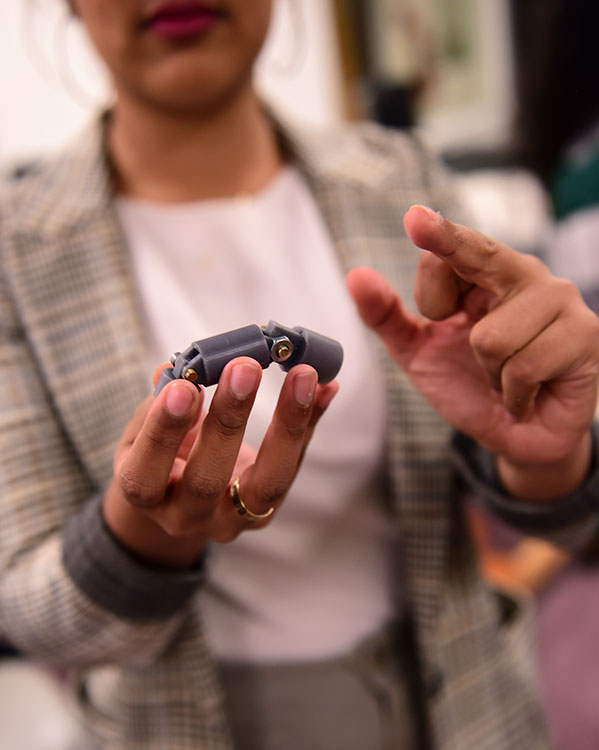

It’s not often that a final class project includes printing a prosthetic finger using a photopolymerization printer, but that was the case during a recent course in Catholic University’s School of Engineering. The course, Additive Manufacturing, is part of a certificate program the school began offering for graduate students in 2019. As part of the certificate program, students are trained in all aspects of 3D printing, so that they will be prepared to provide expertise to commercial industry and government leaders regarding the applicability, potential risks, and the opportunities of using 3D printed parts in critical systems.
Iriana Garcia Guerra, a master’s student in materials science and engineering, said she enrolled in the certificate program because she was interested in learning as much as she could about the new field.
“I realize how important this new field of additive manufacturing and 3D printing will be in the future,” she said. “People think 3D printing is as simple as pushing a button, but there’s a lot of science behind it.”
She was especially interested in studying the field at Catholic University thanks to the school’s local connections with the Navy and local manufacturing companies. Earlier this year, the School of Engineering purchased a ‘Metal X’ SD printer for metals and established an alliance with the company MARKFORGED in support of education and training associated with additive manufacturing.
“Companies like General Electric and General Motors are already working with metal 3D printers, which are more complicated, and we are one of the few universities in the country to offer a program to learn about that,” Garcia Guerra said.

Grace Pooley earned her bachelor’s in environmental chemistry at Catholic University and is currently pursuing her master’s in materials science and engineering with an environmental focus. She said that she originally thought 3D printing was “too gimmicky.” It was only when she learned of its uses for rapid prototyping and quick solutions for engineers that she began to see the field’s future potential.
“It’s not just engineers, but for anyone who wants to see their vision become a reality,” she said. “When you talk about traditional manufacturing with wood or metals, you have to go through a lot more processing because there’s molding you have to do and chiseling materials away. Additive manufacturing really lets you be imaginative in that you can create these intensely intricate geometries and structures.”
Pooley says she’s learned about the history of additive manufacturing as well as current techniques and software. This spring, she is looking forward to being trained on the 3D metal printer. After earning her master’s, Pooley plans to pursue her doctorate in environmental engineering. She believes her graduate education in 3D printing will serve her well, allowing her to prototype design elements for her doctoral project, which will involve strategic installations of trash nets to collect garbage from the Anacostia River.
“If a piece of the hardware for the net breaks, I will be able to get the dimensions for the piece and have it designed and printed within four hours, with less cost and a quicker turnaround period,” she said. “That’s just one way having this knowledge base will be really helpful.”
So far, Garcia Guerra says she has been so inspired by her additive manufacturing courses that she hopes to pursue the field as a career.
“There are so many fields that will be interested in these skills, whether its biomedical engineering, mechanical engineering, or even the arts,” she said. “After enrolling in this program, I’m more than inspired to pursue this. I think 3D printing is the future and it’s something we need to explore right now.”
Mel Williams, Jr., associate dean of engineering, said he was proud that the engineering program is providing “quality graduate education and research in additive manufacturing and 3D printing as part of the Materials Science and Engineering Program.
“We are excited and pleased about the global interest in 3D printing,” he added.